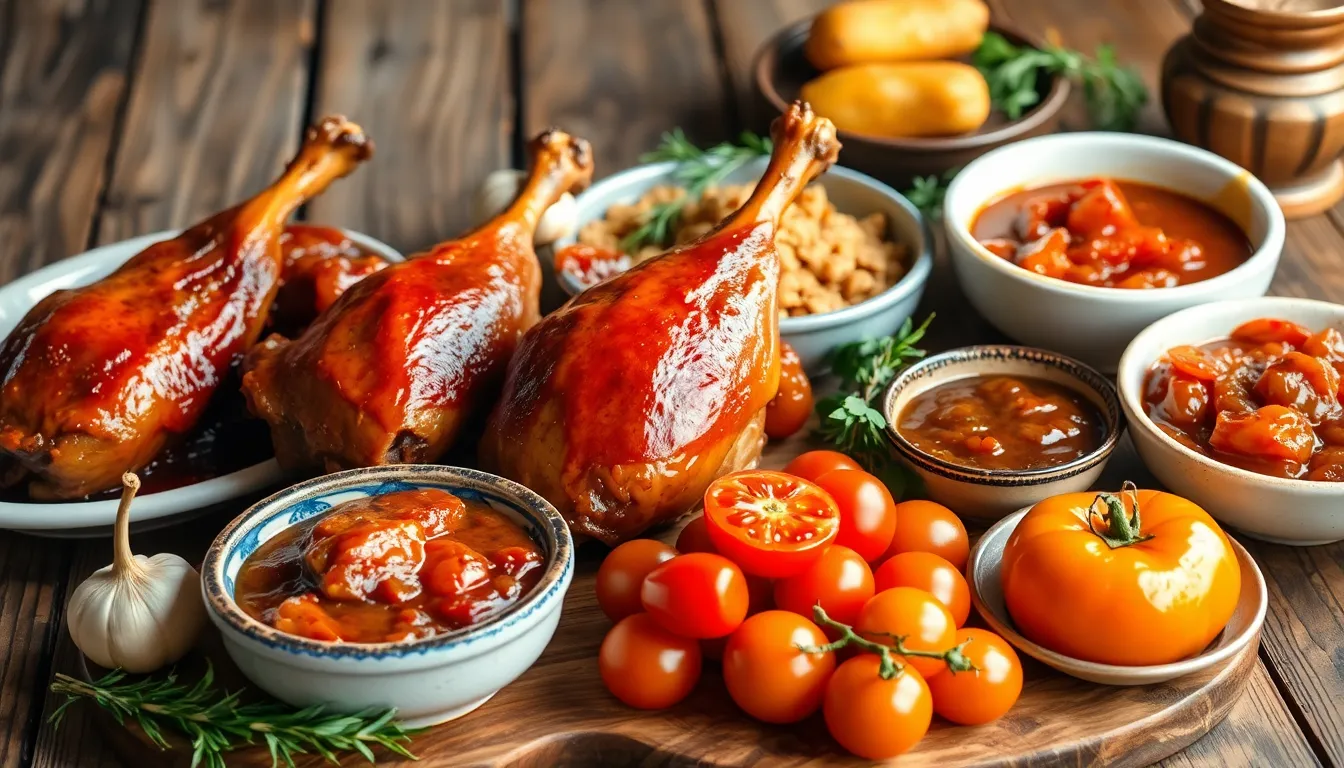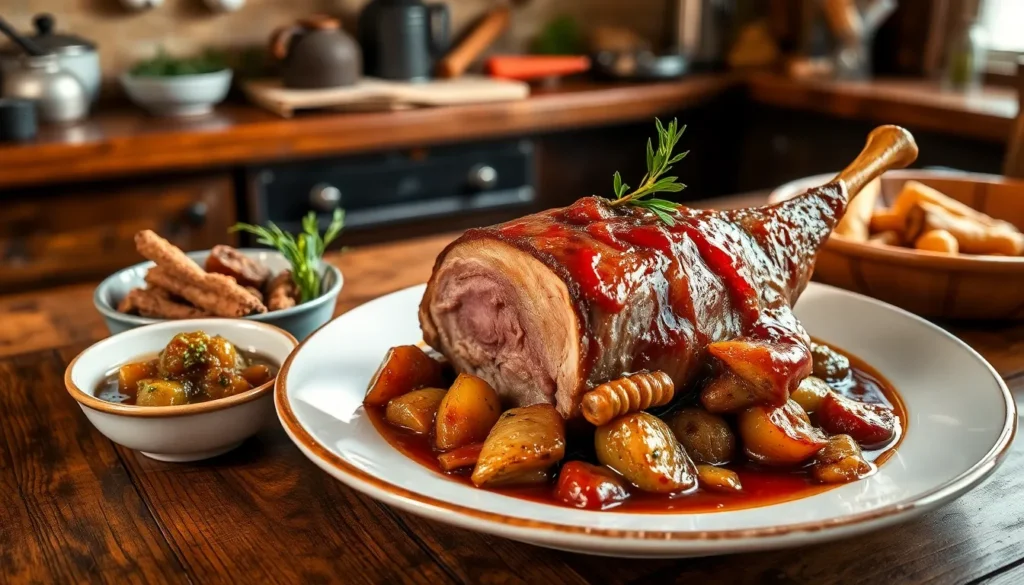Table of Contents
ToggleConfit cooking is a time-honored technique that transforms simple ingredients into culinary masterpieces. Originating in France, this method involves slowly cooking food in its own fat, resulting in rich flavors and tender textures. Whether it’s duck, garlic, or vegetables, confit elevates dishes to new heights, making it a favorite among chefs and home cooks alike.
As the popularity of confit cooking grows, so does the curiosity surrounding its processes and benefits. This technique not only enhances flavor but also serves as a preservation method, allowing ingredients to be stored for longer periods. Dive into the world of confit cooking and discover how this age-old method can bring depth and sophistication to everyday meals.
What Is Confit Cooking?
Confit cooking refers to a traditional French method of preserving and preparing food by slowly cooking it in its own fat. This technique enhances flavors and creates tender textures. Ingredients like duck, garlic, and vegetables are commonly used, showcasing the versatility of confit.
The process involves cooking food at low temperatures, typically between 190°F and 210°F (88°C and 99°C). This gentle cooking method helps break down tough fibers while locking in moisture. Chefs and home cooks alike appreciate confit for its ability to infuse robust flavors and for its preservation qualities.
Notably, confit serves as a natural preservation method. When food is submerged in fat, it becomes less susceptible to spoilage, allowing extended storage without refrigeration. This makes confit an enduring technique, linking centuries of culinary tradition to modern kitchens.
The History of Confit Cooking

Confit cooking boasts a rich heritage rooted in French culinary tradition. This method has evolved over centuries, establishing itself as a fundamental technique in global gastronomy.
Origins and Evolution
Confit traces its origins to the 14th century in southwestern France. Initially, cooks used confit to preserve meats, particularly duck and goose, in their own rendered fat. This technique provided a means to store food without refrigeration, extending shelf life for months. Over time, confit cooking spread throughout Europe, adapting to various regional ingredients and preferences. By the 19th century, chefs began to experiment with other foods, such as garlic and vegetables, expanding the technique’s versatility.
Traditional Uses
Confit has traditionally centered around rich ingredients like duck legs, known as “confit de canard.” The slow cooking process highlights the meat’s flavors and tenderizes the tough fibers, creating a succulent final product. Garlic confit, another classic example, involves slowly simmering garlic cloves in olive oil until they become soft and sweet, enhancing dishes with its nuanced flavor. Similarly, confit vegetables, such as tomatoes or carrots, have emerged as popular accompaniments, retaining their structure while infusing vibrant taste into various cuisines.
The Benefits of Confit Cooking
Confit cooking offers significant advantages, including enhanced flavor and effective preservation. This traditional technique elevates culinary experiences while ensuring food lasts longer without spoilage.
Flavor Enhancement
Flavor enhancement occurs through the slow cooking process, which infuses fat into the ingredient. Duck confit, for example, delivers a savory richness while remaining moist and tender. Garlic confit transforms raw garlic’s sharpness into a sweet, mellow condiment, perfect for various dishes. Confit vegetables, such as tomatoes and carrots, maintain their structure while absorbing the savory essence of the fat. The low cooking temperature promotes a breakdown of tough fibers, resulting in flavors that deepen over time.
Preservation Techniques
Preservation techniques inherent in confit cooking effectively extend food shelf life. Fats act as a barrier against air, inhibiting the growth of spoilage-causing bacteria. Traditional methods can keep confit products edible for months without refrigeration. This technique empowers cooks to store excess seasonal produce, ensuring ingredients remain available year-round. Overall, confit serves not only to enhance flavors but also to create practical storage solutions for a variety of foods.
Essential Ingredients for Confit Cooking
Confit cooking relies on specific ingredients to achieve its rich flavors and tender textures. Understanding these essential components enhances the confit cooking experience.
Types of Fats
- Duck Fat: Known for its rich, savory flavor, duck fat is traditional for duck confit and provides an unmatched depth to meats.
- Pork Fat: Also referred to as lard, pork fat offers a mild taste and works well for confiting various proteins, including pork and rabbit.
- Olive Oil: Used for confiting vegetables, olive oil adds a fruity note and pairs well with herbs and spices for enhanced flavor.
- Beef Tallow: This fat can create a robust flavor in meats and is excellent for confiting tougher cuts of beef, making them tender.
- Goose Fat: Similar to duck fat, goose fat provides richness and is often used for confiting goose or mixed with other fats for various dishes.
Proteins and Seasonings
- Meats: Duck, pork, and goose are commonly confited proteins. These meats benefit from slow cooking, enhancing tenderness while deepening flavor.
- Garlic: Garlic confit transforms raw garlic into a sweet, spreadable condiment that enriches many dishes, from pastas to dips.
- Vegetables: Tomatoes, carrots, and garlic are popular confit vegetables. They absorb the fat’s flavor while retaining their structure, creating vibrant dishes.
- Herbs: Thyme, rosemary, and bay leaves infuse the fat during cooking, amplifying the taste of the main ingredients and harmonizing flavors.
- Spices: Adding black pepper, chili flakes, or fennel seeds can elevate the flavor profile, adding warmth and complexity to confited dishes.
Confit Cooking Techniques
Confit cooking involves methods that ensure optimum flavor and texture through precise techniques. Understanding the step-by-step process and common mistakes helps refine confit skills.
Step-by-Step Process
- Select Ingredients: Choose proteins like duck, pork, or vegetables, along with high-quality fat.
- Prepare the Ingredients: Trim and season the proteins with salt and herbs. For vegetables, wash and cut into desired sizes.
- Heat the Fat: In a heavy-bottomed pot, warm the fat over low heat until just melted.
- Add Ingredients: Submerge the prepared ingredients completely in the fat, ensuring no air pockets remain.
- Cook Slowly: Maintain a low temperature between 190°F and 210°F (88°C and 99°C) for several hours, allowing flavors to develop and tenderize the ingredients.
- Cool and Store: Once cooked, let the confit cool in the fat, then transfer to airtight containers, ensuring the fat covers the ingredients completely.
- Refrigerate: Store in the refrigerator, which can extend shelf life for several weeks.
Common Mistakes to Avoid
- Overheating the Fat: Cooking at high temperatures can create an undesirable flavor and texture.
- Insufficient Seasoning: Under-seasoning can lead to bland results; seasoning before cooking enhances flavor absorption.
- Improper Storage: Not covering the ingredients with fat can expose them to air and result in spoilage.
- Skipping the Cooling Step: Failing to cool the confit in the fat can affect the preservation and flavor.
- Inconsistent Cooking Time: Rushing the cooking process compromises texture; ensure sufficient time for flavors to meld.
Popular Confit Dishes
Confit cooking lends itself to a variety of dishes, each showcasing the rich flavors and tender textures achieved through this method. Two standout examples are duck confit and tomato confit, both beloved in culinary circles.
Duck Confit
Duck confit ranks as one of the most iconic confit dishes. The process involves slow-cooking duck legs in their own fat, leading to meat that’s exceptionally tender and juicy. Cooks typically season the duck with salt and herbs before immersing it in rendered fat, allowing the flavors to meld during the extended cooking time at low temperatures. The result is rich, savory meat that pairs well with various sides like potatoes or salads. Duck confit also serves as a versatile ingredient, enhancing dishes such as tacos, pasta, or savory pies.
Tomato Confit
Tomato confit offers a delightful way to enjoy the vibrant flavors of this fruit. Chefs slice tomatoes and gently cook them in olive oil along with herbs and garlic, allowing them to soften and concentrate in flavor. This slow cooking method retains natural sweetness while creating a tender texture. Tomato confit can be used as a topping for bruschetta, incorporated in sauces, or served alongside grilled meats. Its versatility makes it a favorite in Mediterranean cuisine, elevating simple dishes with its rich, nuanced taste.
Embracing confit cooking opens up a world of rich flavors and culinary creativity. This time-honored technique not only transforms ingredients but also enhances their shelf life, making it a practical choice for any kitchen. Whether it’s the savory allure of duck confit or the sweet notes of garlic confit, this method brings depth to dishes while preserving seasonal bounty.
As home cooks explore confit, they’re likely to discover new ways to elevate everyday meals. The versatility of confit encourages experimentation with various ingredients, inviting everyone to savor the delicious results. By integrating this technique into their culinary repertoire, cooks can celebrate tradition while enjoying the modern benefits of flavor and preservation.




